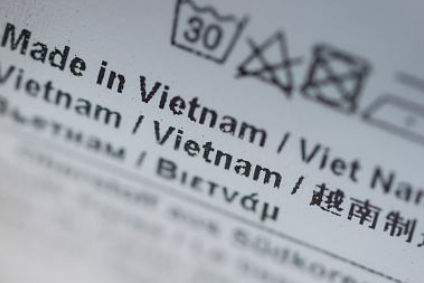
Vietnam’s textile and garment industry is targeting exports of US$34bn in 2018 as it looks to invest more in technology to increase productivity and shorten delivery times, and increase its focus on markets such as Australia and Russia.
New figures from the Vietnam National Garment and Textile Group (Vinatex) show global textile and apparel demand fell by 0.85% in 2017, compared to a year earlier. Within this, US imports were down 0.2%, and EU imports by 0.3%.
Despite this, and pressure from the abandonment of the Trans-Pacific Partnership (TPP) trade deal last year, Vietnam’s textile and garment industry surpassed its 2017 target of $30bn with an export turnover of over $31bn, an increase of 10.2% on the prior year.
Aside from the production of traditional textiles, Vietnam has benefited from a focus on high value added products such as fibres, geotextiles, and textile and garment accessories.
Good growth was also maintained by Vietnam’s major export markets of the US, the European Union (EU), Japan and South Korea in 2017, while there were breakthroughs in exports to other markets such as China, Russia and Cambodia.
At present, companies in Russia cannot make payments direct, but through a third-party bank. If this is resolved, Vinatex believes Russia, along with Australia, could be the next two $1bn export markets for Vietnam.

US Tariffs are shifting - will you react or anticipate?
Don’t let policy changes catch you off guard. Stay proactive with real-time data and expert analysis.
By GlobalDataVinatex general director, Le Tien Truong, says the balance in development of the domestic market and the export market has been an important point for the local textile and garment industry to ensure jobs and to maintain development of the sector’s enterprises.
The industry has been focused on improving the capacity of production management, product quality, timely delivery and investment in upgrading machinery and equipment. Yet Truong says the sector needs to be prepared for the Industry 4.0 revolution and the challenges that will bring in terms of competition and development. Like foreign garment manufacturers, Vietnam also needs to invest in more modern factories, he explains, in order to prevent losing opportunities.
According to Vinatex, the average unit price, particularly for standard orders such as shirts and trousers, dropped by 10% to 15% in 2017 and is expected to continue to decrease, while costs such as energy, wages and transport in Vietnam continue to rise.
“The only way to compete with textile exporters in general and with FDI enterprises in particular, is to reduce the labour cost per unit of output,” explains Truong. “If any equipment can replace manual labour, [companies] will have to invest.”
He says that while the investment will be more, the return will be the ability to pay higher wages, a reduction in the rate of return, and ultimately, an improvement in business performance.
“With the advent of technology, new textile businesses can increase productivity, shorten delivery times, and increase wages for workers,” he adds.
At the present annual growth rate of 10%, the sector needs to recruit an additional 200,000 employees each year. With a focus on high-tech equipment, Truong believes the sector would only need to recruit half of that number yet maintain the growth rate.
As such, Vietnam’s textile and garment industry is focused on achieving a target of $35bn in exports in 2018, a 10% increase on 2017. This is despite global political and economic instability, particularly in Korea and the US, which could have a negative impact on consumer demand.
“The industry must devote itself to changing technologies, taking the lead in investing and mastering the products on the world market in order to create a stable, sustainable and efficient textile and garment industry,” says Truong.



